What are nose piercing bumps?
Listed below are the top five causes of bumps at the site of a nose piercing:
pustule
As the name suggests, this nasal bulge is full of pus. Think of a pustule as a pimple or blister at the piercing site. Sometimes they are caused by mild infections. In other cases, they are caused by trauma, e.g. B. by pulling or tightening your piercing.
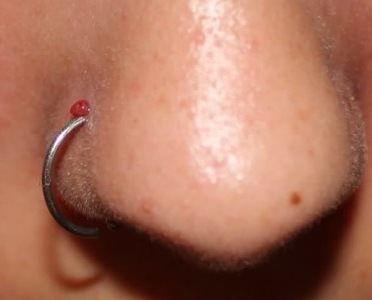
Granuloma
The schedule of when your piercing was done can help you figure out if you are dealing with a granuloma. They don't appear immediately after a nose piercing. On average, it takes about 6 weeks for these annoyances to occur.
Granulomas can appear in your piercing hole or right next to it. They can be as little as a few millimeters or just a few inches.
Granulomas form when the tissue around the piercing continues to grow and is caused by trauma or your body's inflammatory response to deal with the piercing wound, which it views as an unwanted invasion.
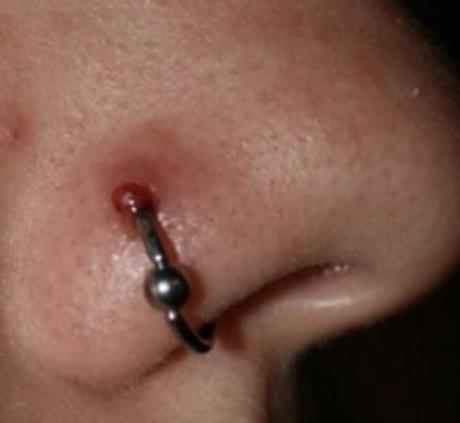
Keloid
A keloid is a fancy term for a scar. However, it's not an ordinary scar - it's like a scar on steroids. Keloids are very thick and often very noticeable. Unlike other forms of scarring, keloids can grow up and out through adjacent tissue. Therefore, if you are concerned, it is a good idea to spot them as soon as possible.
If you see formation around your piercing site and you are not sure if it is a keloid, make an appointment with your doctor or piercer. You will have seen enough keloids and temporary hypertrophic scars to tell the difference between the two.
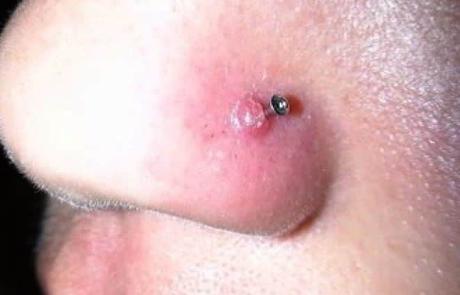
infection
Sometimes bacteria can get into the wound and cause infection, which in turn can lead to the formation of a lump as the body tries to fight and expel the bacteria that are causing the infection.
Excessive swelling
Sometimes inflammation and swelling can cause a small bump to form in the area. If there is no infection, it shouldn't take too long for the bump to fall off.
When to see a doctor
Although you should expect at least minor redness and swelling after getting a nose piercing, signs of a more serious problem could include:
- Severe pain at the piercing site. This includes sharp pain, burning, and throbbing
- Uncomfortable or prolonged level of tenderness in the area
- Leaking pus / discharge or unpleasant smells from the penetrating wound
If you experience any of these symptoms, it is recommended that you contact your piercer or doctor as soon as possible for further advice.
In these cases it is also important that you do not remove your jewelry. Once the piercing jewelry is removed, a nasal piercing hole can close quickly and trap potentially harmful bacteria in the wound, potentially leading to a serious infection.
How to get rid of nose piercing bumps
The first thing you need to do before creating a plan of attack is to decide what is causing the bump in the first place. Once you have come to a conclusion, you can begin your journey to become bumpless.
infection
If you think it may be an infection, you should have your piercer or a doctor examined to determine the best course of action.
If your infection is severe, your doctor will usually prescribe a course of antibiotics to help keep control. However, if it is decided that the infection is minor, the area is cleaned with a saline solution a few times a day to usually clear things up.
It's good to know that while infection can be impractical, it is usually easy to treat if treated immediately.
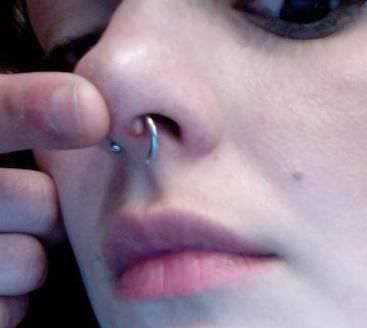
A granuloma
Just because a granuloma forms doesn't mean you have to live with it.
While some granulomas will go away on their own over time, this is not guaranteed and you may need to see a dermatologist for treatment. Treatment methods include corticosteroid creams, freezing, and light therapy.
A pustule
While you want your pustule to drain naturally, you should never lance it yourself without having the proper, sterile equipment in place. Pricking with a needle or safety pin that you have lying around around the house may seem like a good idea at this time, but it can lead to infection.
If your pustule doesn't drain on its own and you need to have it stung, you should go to a doctor's office to have it done.
A keloid bump
Keloid bumps can be extremely difficult to get rid of without the outside help of a dermatologist / surgeon.
Since keloids are basically lumps or scar tissue, they are very unlikely to go away on their own (although they can diminish slightly over time).
While surgery to remove scar tissue is a common practice for removing keloid scars that have become large and bulky, various other treatment options are available, such as: B. retinoid cream or steroid Injections and silicone gel application.
Swelling / irritation
Sometimes a bump will form if the area is particularly irritated or swollen. In this case, the bump should slowly decrease over the course of a week.
While this swelling is just the body's way of dealing with damage caused by the prick needle, you can try to speed up the healing process by trying these home remedies:
Chamomile compress
Chamomile contains great healing properties that can accelerate the healing rate of the skin surrounding your piercing.
- The easiest way to use chamomile is to buy it in a tea bag.
- From here, simply soak in half a cup of lukewarm water for five minutes.
- Once the water has drawn out the chamomile contents, soak up some of it with a cotton ball and press it against the bump for 5-10 minutes.
Diluted tea tree application
Like chamomile, the tea tree has some great healing properties. Not only is it antiseptic and antimicrobial, but it also helps reduce inflammation around the piercing.
Dab a small amount of diluted tea tree on your piercing bump with a Q-tip can help reduce the exacerbations that appear under the skin.
A word of caution: tea tree can cause an adverse skin reaction in a small number of people. Before using it on your nose shaft, always do a patch test first by placing a small amount of diluted tea tree on your forearm and checking 24 hours later that your skin is not reacting badly to the solution.
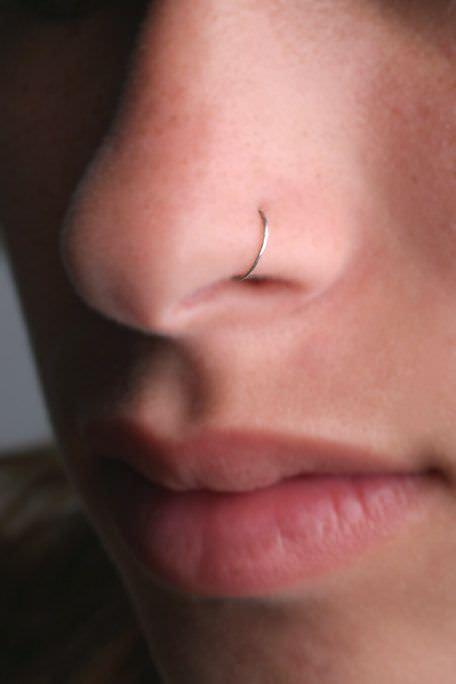
Do Nose Piercing Bumps Cause Long Term Damage?
Granulomas can go away on their own, but it can take months. Keep doing sea salt compresses and see if that helps. Ask your dermatologist about your options. In some cases, they can recommend treatment or even removal.
Keloids are scars, so they won't go away without a visit to the dermatologist's office. Typically, your options for reducing the occurrence of a keloid include cryotherapy, corticosteroid injections, and even surgery. They can be removed by surgery, but even then, in some cases, they can come back.
While waiting for your treatment, be careful not to pick the keloid. They could cause additional scars or even more damage to the skin, which could increase the risk of infection.
What if the bump doesn't go away?
If you've carefully managed to follow all of the advice in this article and your nose piercing still doesn't look what you'd expect after a few weeks due to a bump around the fabric / jewelry, then it is probably best to look for it further medical / professional help.
You may want to consult your original piercer first for professional advice as they have most likely seen these issues multiple times in the past.
Otherwise, or if your situation worsens significantly, it is wise to see a doctor as soon as possible in case you contract a nasty infection.
prevention
If you have had pierced ears in the past and reacted to a certain type of metal in your earrings, let your piercer know. For example, if you have already reacted to nickel, you need to avoid jewelry that uses this metal when getting your nose pierced.
Any material that reacted in your ear piercing will also react in your nose piercing. You have to speak out loud. Your piercer will not be a mind reader. You need to know about any concerns you have.
If you have had keloids in the past, or if you have a parent who has them, let your piercer know before undergoing the procedure. Risks of developing keloids can run in the family. Hence, it may be a red flag that you want to consider how much you want this nose piercing.
If you don't know a family history related to keloids, there are additional risk factors that make you more likely to develop them. People with darker skin are more prone to keloids. Pregnant women seem to be more at risk. Some types of medication also increase the chances of developing keloids.
People who know in advance that they are at a higher risk of getting keloids may want to start with a piercing that is in a less noticeable area than their nose. Based on that experience, they can then determine from there whether it is worth the risk of continuing their nose piercing.
